1922 continued the uptick in new aircraft design, and construction. Better fighters and bombers were in demand for colonial wars, while seaplanes lined up for innovative aircraft carriers launching from ship yards.
Several innovative fast racing aircraft kept the bar above 200 mph. While passenger aircraft, large and small continued to tempt the new taste for passenger flight.
The overall trend showed the industry had shrugged off the anything-goes culture of World War 1. Military, civilian and private customers were more discerning now the scramble was over. They wanted better looking aircraft that flew higher faster.
JANUARY 1922
The first commercial night flights between London and Paris commence. The aircraft were likely to have been modified Handley Page Type O/400 bombers.
Austro-Hungarian-born German physicist and engineer Henry Oberth publishes a dissertation concerning sending rockets to the planets, and is hotly disputed. He bypasses his academic critics by publishing his opinions in a book.
Czechoslovakian Aero Letňany A.10 Biplane Airliner
The Aero Letňany A.10 biplane airliner was the first commercial aircraft to be built in Czechoslovakia, and became known locally as the ‘Aero-10 Limousine’. It had several innovative features that made it stand out after first flying on January 3, 1922. However, only 5 were delivered to the local Československé Státní Airline, where it delivered service from 1923 until 1928.
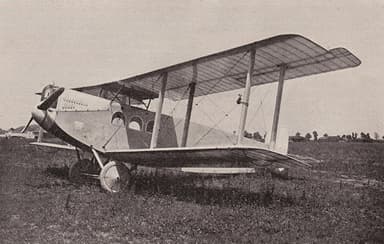
https://en.wikipedia.org/wiki/File:Aero_A-10.jpg
The pilot and navigator shared an open cockpit behind semi-insulated passenger accommodation. This was below them in the forward fuselage behind the engine, and featured three seats and two tables. The latter flipped over to create two more upholstered seats. A rear window facilitated communication with the pilot.
The upper wings with ailerons were in three sections, with the fuel tank in the center one. The deep, rectangular fuselage tapered to a vertical knife-edge at the rear, eliminating the need for a tail fin. However, the tail plane carried two balanced elevators hinged to the stabilisers, and a balanced rudder was fitted to the top of the fuselage.
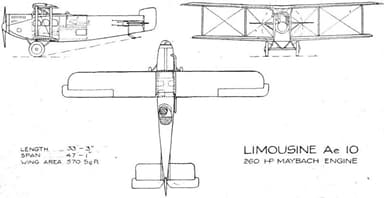
https://en.wikipedia.org/wiki/File:Aero_Ae_10_3-view_Flight_June_15,_1922.jpg
The specification of the Aero Letňany A.10 was as follows:
- Length 33 ft, height unavailable, wing span 46.5 ft, wing area 530 sq ft
- Empty weight 3,245 lb, max take off 4,982 lb, crew two, max 5 passengers
- Maybach Mb.IVa 6-cylinder water-cooled inline piston engine, 260 hp
- Max speed 99 mph, cruise 87 mph, endurance 4 hrs, ceiling 20,000 ft
https://en.wikipedia.org/wiki/Maybach_Mb.IVa#/media/File:Maybach_Mb_IVa.jpg
MARCH 1922
Portuguese pilots Gago Coutinho and Sacadura Cabral complete a flight from Portugal to Brazil, using three Fairey III reconnaissance biplanes for a series of sequential flights.
French Breguet XIX Light Bomber and Reconnaissance Aircraft,
The Breguet XIX light bomber and reconnaissance aircraft, also known as Br.19 or Bre.19, formed the backbone of the French air force through to 1935. Approximately 2,700 were produced. Some were still in colonial service until 1938, suppressing rebellions.

https://en.wikipedia.org/wiki/File:Breguet_XIX_prototype_L%27Aerophile_December,1921.jpg
The Breguet XIX made extensive use of duralumin as construction material, replacing some steel or wood. It was faster than other bombers, and even some fighter aircraft when first displayed, and attracted huge international interest spurred on by its sporting success.
The secret lay in its variety of powerful engines, since for the rest, it was a conventional biplane, with canvas-covered wings over the duralumin front part, and a canvas-covered tail section behind. It had conventional, fixed landing gear and tail skid, with the pilot and observer/bombardier sitting in tandem open cockpits.
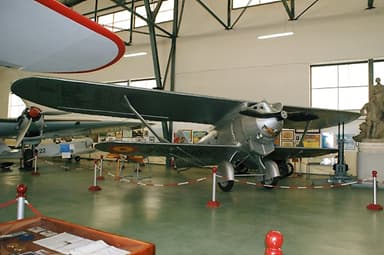
https://en.wikipedia.org/wiki/File:Breguet_XIX_TR_Bidon_%22Jesus_del_Gran_Poder%22_(5381217697).jpg
The specification of the Breguet XIX Br 19 A.2 Variant was as follows:
- Length 31.5 ft, height 12 ft, wing span 48.5 ft, wing area 540 sq ft
- Empty weight 3,058 lb, max take off 5,512 lb, crew two
- Lorraine 12Ed Courlis W-12 liquid-cooled piston engine, 450 hp
- Max speed 133 mph, range 500 mi, service ceiling 23,600 ft
- One fixed, forward-firing 0.30 inch Vickers machine gun
- Two flexible, rearward-firing 0.30 inch Lewis Guns.
- There was also provision for assorted light bombs.
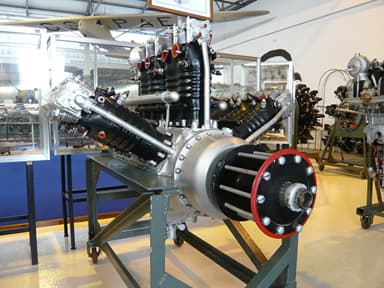
https://upload.wikimedia.org/wikipedia/commons/thumb/0/0b/Museu_do_Ar_-_Lorraine_Dietrich_12Eb_450cv_W-12_engine%282948374339%29.jpg/1024px-Museu_do_Ar_-_Lorraine_Dietrich_12Eb_450cv_W-12_engine%282948374339%29.jpg
British de Havilland DH.34 Single Engine Biplane Airliner
The de Havilland DH.34 was a single engine British biplane airliner that first flew on March 22, 1922, after which a total 12 entered service with several airlines. De Havilland aborted construction of several other ventures, to meet growing demand for a larger, more economical aircraft.
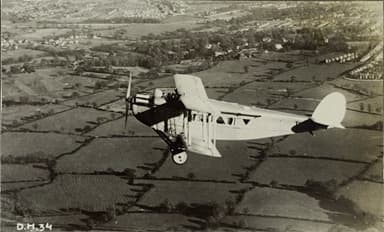
https://commons.wikimedia.org/wiki/File:De_Havilland_DH.34_in_flight_-_Ans_05338-02-118-AL-FL.tif
The De Havilland DH.34 had a wooden, plywood-clad fuselage. The cockpit for two pilots was ahead of the two-bay wooden wings and passenger cabin. The unusual shape of the cabin doors allowed a spare engine to be loaded and unloaded.
A specially-fitted ‘porthole’ on the far side of the cabin could be removed to allow the propeller boss to protrude out the other side of the aircraft. However, in this case there was no room for passengers, the purpose being to move spares swiftly to remote destinations.
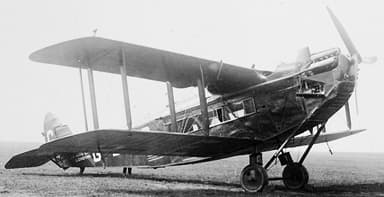
https://commons.wikimedia.org/wiki/File:De_Havilland_DH.34_Daimler_Hire_Ltd_-_Ans_05338-02-117-AL-FL_(tight_crop,_white_balance,_grayscale).jpg
The de Havilland DH.34 opened up a Channel air service between England and France, with 8,000 hours clocking up in the first nine months. However, six production models were lost in accidents over four years. A high stall speed of 63 mph may have contributed to this.
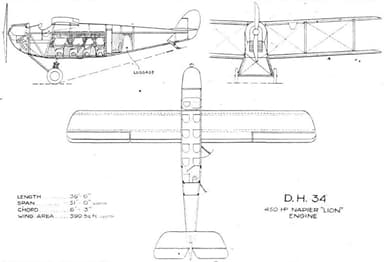
https://commons.wikimedia.org/wiki/File:De_Havilland_DH.34_3-view_Flight_January_5,_1922.jpg
The specification of the De Havilland DH.34 was as follows:
- Length 39 ft, height 12 ft, wing span 51.5 ft, wing area 590 sq ft
- Empty weight 4,574 lb, gross weight 7,200 lb, crew two, passengers ten
- Napier Lion W-12 water-cooled piston engine, 450 hp
- Max speed 128 mph, cruise 105 mph, stall 63 mph, range 317 mph
APRIL 1922
Germany begins secretly training aircraft pilots at Lipetsk in Russia. By 1933, 450 German military pilots will have trained there
MAY 1922
British pilots Wilfred T. Blake, Norman Macmillan, and L. E. Broome leave on a round-the-world flight in a modified Airco DH.9. Their trip from London takes them via Calcutta, Vancouver, Montreal and Quebec. By the time they return on September 7 1922, they have covered 23,690 miles.
British pilot Cyril Turner performs the first skywriting project, after using special smoke to write ‘Daily Mail’ in the sky over Epsom Downs Racecourse in Surrey, England.
JUNE 1922
A Russian pilot completes the first flight between London and Moscow flying an Avro Baby.
American aviation visionary Henry Berliner demonstrates a primitive helicopter to the United States Army. He hovers above the ground while assistants hold the aircraft steady.
JULY 1922
British Type 72 Monoplane Racer
The Bristol Racer was built to demonstrate the capabilities of the Bristol Jupiter engine, thousands of which were used later on many aircraft designs during the 1920s and 1930s. It was a single-engine mid-wing monoplane, with unusually for that time a retractable undercarriage.
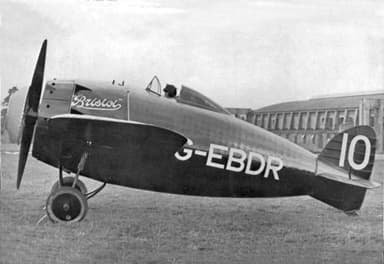
https://za.pinterest.com/pin/421860690075049233/
A full enclosure with elaborate arrangement of ducts channeled cooling air over the cylinders, and there was also an opening to admit air past the large spinner. The fuselage was constructed around a pair of circular steel frames, to which the wing root stubs were mounted.
However, beyond this point to the rear the construction was semi-monocoque built up from three laminations of tulipwood over hoops, which were braced with radial wires. The fabric-covered wings had composite steel-and-wood frames without bracing. A crank and a chain drive operated the retractable undercarriage.
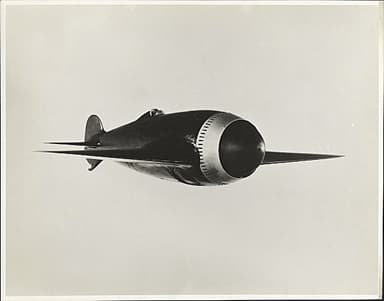
https://en.wikipedia.org/wiki/Bristol_Racer#/media/File:Bristol_Racer.jpg
The specification of the Bristol Type 72 was as follows:
- Length 21.5 ft, wing span 25 ft, max speed 220 mph, crew one
- Bristol Jupiter IV seven / nine-cylinder piston radial engine ,480 hp
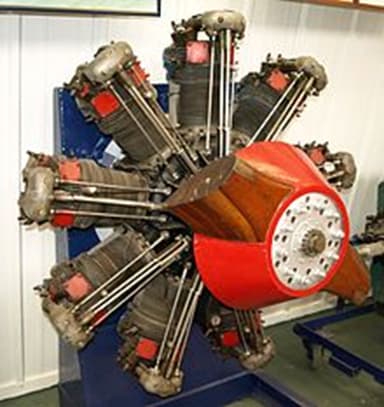
https://en.wikipedia.org/wiki/Bristol_Jupiter
German Junkers T 19 Single-Engine Small Passenger Monoplane
The Junkers T 19 was ahead of its time, but too expensive for the market to afford. Nonetheless it had innovations that deserve it a page in aviation history. In better days it might have become exclusive transport for the rich and famous. However, this time Junker’s foray into the private market was not a success.
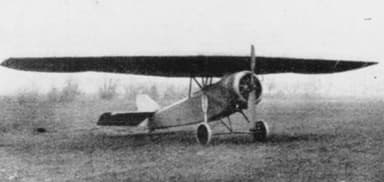
https://en.wikipedia.org/wiki/File:Junkers_T-19_NACA-TM-370.jpg
The Junkers T 19 monoplane failed to capture market share, because the duralumin over a wooden frame made it expensive. Its parasol wings did away with lift struts to the mid wing, which relied on support via V- and inverted-V struts from the upper fuselage.
The tapered fuselage was flat sided, with a long open cockpit reaching from leading to trailing edge of the wings. The pilot sat immediately behind the engine, while seats for one or two passengers were available in the rear, with access via a triangular shaped starboard side door.
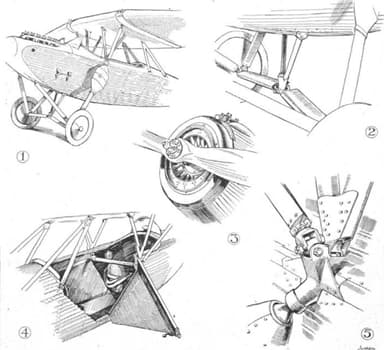
https://histaviation.com/Ju_t_19.html
The speciation of the Junkers T 19 was as follows:
- Length 20 ft, height 9 ft, wing span 37 ft, wing area 205 sq ft
- Empty weight 1,158 lb. gross weight 1,677 lb, crew one, two passengers
- Armstrong Siddeley Genet 5 cylinder radial, air cooled 80 hp engine
- Max speed 83 mph, cruise speed 68 mph, service ceiling 13,000 ft
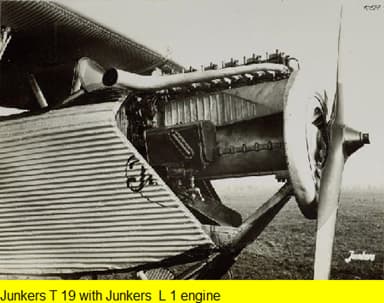
https://histaviation.com/Ju_t_19.html
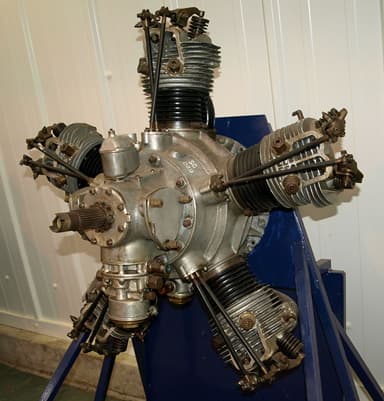
https://en.wikipedia.org/wiki/Armstrong_Siddeley_Genet#/media/File:ASGenet.JPG
AUGUST 1922
German aviator Arthur Martens completes the first sailplane glider flight of over one hour, remaining aloft for 66 minutes.
British Vickers Type 56 Victoria Cargo and Troop Carrier
The Vickers Type 56 Victoria was a twin engine, biplane troop transport designed for the Royal Air Force. It flew for the first time on August 22, 1922, whereafter a total 97 were delivered to squadrons in Hinaidi, Iraq and Heliopolis, Egypt.

https://en.wikipedia.org/wiki/File:Vickers_Victoria_ExCC.jpg
The Vickers Victoria was an amalgam of the fuselage of the earlier Vernon transport, with the wings of the Virginia bomber, which was developed in parallel. The enclosed cabin had room for 24 troops on collapsible canvas seats, arranged along the sides of the fuselage.
The two Napier Lion engines mounted directly on the lower main planes, with fuel tanks beneath the inboard section. Although these later moved to beneath the upper main planes in later versions. Early models had wooden airframes, but metal structures subsequently replaced these.

https://en.wikipedia.org/wiki/File:THE_ROYAL_AIR_FORCE_1919_-_1939_H(AM)345.jpg
The specification of the Vickers Victoria was as follows:
- Length 59.5 ft, height 17.5 ft, wing span 87.5 ft, wing area 2,178 sq ft
- Empty weight 10,030 lb, gross weight 17,760 lb, crew two, troops 22
- Two Napier Lion XI 3-bank 12-cylinder piston engines, 570 hp each
- Max speed 110 mph, range 770 mi, ceiling 16,200 ft, climb 11 min / 4,920 ft
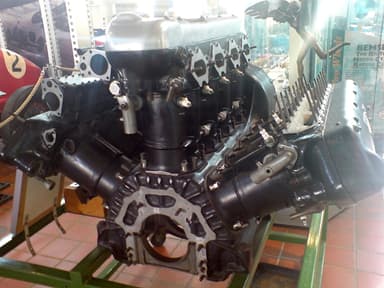
https://en.wikipedia.org/wiki/Napier_Lion#/media/File:Napier_Lion_W12_@_Brooklands_Museum.JPG
SEPTEMBER 1922
American pilot Jimmy Doolittle flies across the United States in a de Havilland DH.4 in 21 hours. The flight takes him from Pablo Beach, Florida to Rockwell Field, California.
French aviator Joseph Sadi-Lecointe makes the first flight at over 200 mph, flying a Nieuport-Delage NiD 29.
OCTOBER 1922
The German Junkers company secretly establishes an aircraft factory at Fili in the Soviet Union.
Americans John A. Macready and Oakley G. Kelly set a flight endurance record of 35 hours 18 minutes in a Fokker T-2.
Alexis Manyrol of France wins a glider competition with a world-record 201-minute flight in his Peyret tandem monoplane glider.
United States Army Air Service Lieutenant Harold Harris makes the first parachute escape from a stricken aircraft, bailing out of a Loening PW-2 over Dayton, Ohio.
American pilot Amelia Earhart sets a new women’s altitude record, reaching 14,000 feet.
American Navy-Wright NW-1 Test Bed-Racer Sesquiplane
The Wright Aeronautical company built an exceptionally powerful, 1,000 pound weight, V-12 aircraft piston engine with a nominal output of 500 horsepower. However, there was no known aircraft able to use the 1922 T-2 version properly, and so the U.S. Navy asked Wright Corporation to build an airframe able to accommodate it.
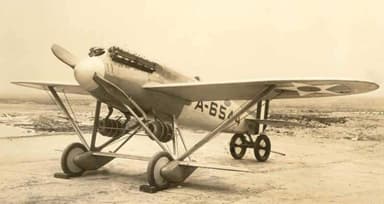
https://en.wikipedia.org/wiki/File:Navy-Wright_NW-1_Mystery_Ship.jpg
The Navy-Wright NW-1 sesquiplane that emerged had, as the name suggests a considerably scaled-down lower wing to reduce weight and drag. The main wheels were faired into this lower winglet. Bracing was likewise considerably reduced, although the radiators still hung beneath the fuselage to optimize cooling.
There was insufficient time to fully test the Navy-Wright NW-1 before the Pulitzer race for that year, although it did achieve 209 mph during a test flight. The engine overheated during the competition, and the pilot had to ditch in Lake St. Clair, flipping the aircraft over on its back after reaching 186 mph.

https://airandspace.si.edu/collection-objects/wright-tornado-t-3-v-12-engine/nasm_A19660461000
A new seaplane version, NW-2 arose from the wreckage the following year. It reached 176 mph before the propeller failed and sliced into the floats. The pilot landed safely in the water, but the floats collapsed and it sank. The U.S. Navy abandoned the project.
The specification of the Navy-Wright NW-1 was as follows:
- Length 24 ft, height 11 ft, wing span 30.5 ft, wing area 180 sq ft
- Empty weight 2,480 lb, gross weight 3,000 lb, crew one
- Wright T-2 , 525 hp (650 hp realized in test) V-12 piston engine
- Maximum speed 209 mph, endurance 1.6 hours
NOVEMBER 1922
An aircraft catapult successfully launches a Naval Aircraft Factory PT from the deck of American navy carrier USS Langley.
French Levasseur PL.2 Biplane Navy Torpedo Bomber
The Levasseur PL.2 was a biplane torpedo bomber built for French naval use. Its design relied quite heavily on input from British aircraft manufacturer Blackburn Aircraft. It was a single seat, unequal span aircraft with fixed tailskid landing gear, and a single Renault engine in the nose.
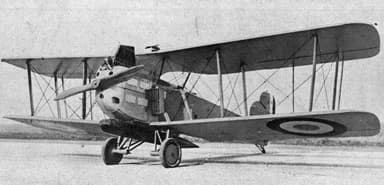
https://commons.wikimedia.org/w/index.php?search=Levasseur+PL.2+&title=Special%3ASearch&go=Go&ns0=1&ns6=1&ns12=1&ns14=1&ns100=1&ns106=1#/media/File:Levasseur_PL.2_L’A%C3%A9ronautique_January,1926.jpg
The first test flight took place in November 1922 using a single propeller, although a later prototype used a four-bladed one. Nine production versions followed in ensuing years.
These were fitted with ballonets and jettison-able landing gear for operations at sea. However, they only entered service aboard the French aircraft carrier Béarn in 1926, where they continued in use until scrapping in 1932.

https://www.destinationsjourney.com/historical-military-photographs/french-aircraft-carrier-bearn/
The specification of the Levasseur PL.2 was as follows:
- Length 49.5 ft, height 13 ft, wing span 49.5 ft
- Gross weight 8,053 lb, crew one, Renault 12Ma 580 hp engine
- Speed 112 mph, range 435 mi, ceiling 8,052 ft
- One 0.303 inch machine-gun, 992 lb torpedo / bombs
German Dornier Do J Wal Twin-Engine German Flying Boat
The Dornier Do J Wal was a twin-engine flying boat that proved a success in military and commercial applications. Over 250 were produced between 1922 and 1932, with the first flight on November 6, 1922, and subsequent production in Italy to avoid the limitations of the Treaty of Versailles.

https://en.wikipedia.org/wiki/File:FMRA311._Dornier_Wal-flyet,_%22N24%22_p%C3%A5_isen_i_Ny-%C3%85lesund_-_no-nb_digifoto_20160412_00254_bldsa_FMRA0311_(cropped).jpg
The ‘Whale’ as it became colloquially known had an upper, high-mounted strut-braced parasol wing, with two piston engines mounted in tandem in a central nacelle upon it. One engine drove a tractor propeller, and the other engine a pusher.
The civilian version had a cabin in the nose providing accommodation for up to 12 passengers, with an open cockpit to the aft of it. Main takers for this version were Germany, Italy, Brazil and Colombia.
However, in the military version the command position for crew was an open cockpit up forward. There were two to three machine guns, one in the bow and the balance further aft. These were supplied to Spain, Argentina, Chile, Netherlands, Yugoslavia, Soviet Union, and Italy.
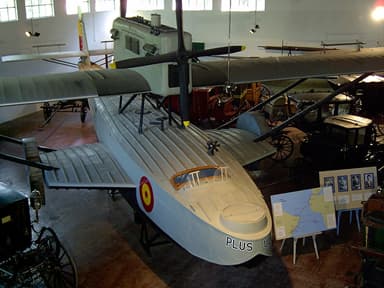
https://en.wikipedia.org/wiki/File:PlusUltra.JPG
The specification of a civilian Do J Wal was as follows:
- Length 56.5 ft, height 18.5 ft, wing span 72 ft, wing area 1,030 sq ft
- Empty weight 8,003 lb, max take off 15,432 lb, crew 3, passengers 8 to 10
- Two Rolls-Royce Eagle IX V-12 water-cooled piston engines, each 355 hp
- Max speed115 mph, cruise 90 mph, range 500 mi, ceiling 11,500 ft
- Rate of climb 300 ft / min, 9,843 ft in thirty-three minutes
French Dewoitine D.1 Single-Seat, Parasol-Wing Fighter Aircraft
The Dewoitine D.1 was designed to meet French military specifications. Accordingly, the monoplane had an oval metal fuselage with duralumin sheet skinning, and a metal strut-braced parasol wing covered over with fabric. The prototype first flew on November 18, 1922, whereafter some 500 were built including all versions.
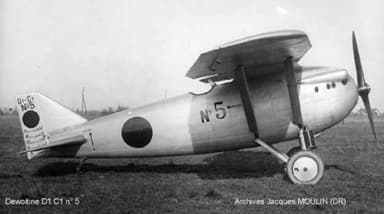
https://commons.wikimedia.org/wiki/File:Dewoitine_D1_C1.jpg
Dewoitine D1 derivatives used a variety of engines. Aircraft were supplied to France, Yugoslavia, Switzerland and Japan. Italy purchased one, and then produced 112 under license. The French military was disinterested. However, the French Navy acquired 30, of which 15 operated off the French aircraft carrier Béarn.
The specification of the Dewoitine D1.01 prototype was as follows:
- Length 24.5 ft, height 9 ft, wing span 37.5 ft, wing area 215 sq ft
- Empty weight 1,808 lb, gross weight 2,734 lb, crew one
- Hispano-Suiza 8 Fb V-8 inline liquid-cooled engine, 300 hp
- Max speed 158 mph, range 249 mi, ceiling 26,245 ft, climb 1476 ft / min
- Two fuselage-mounted synchronized 0.303 inch Vickers machine guns

https://en.wikipedia.org/wiki/Dewoitine_D.27#/media/File:Dewoitine_D.27.jpg
British Vickers Virginia Twin Engine, Heavy Biplane Bomber
The Vickers Virginia was a twin engine, heavy biplane bomber developed from the Vickers Vimy. However, the front gunner’s ‘pulpit’ was lowered to allow the pilot a greater field of view. It also had a twenty-foot larger wingspan, and a nine-foot longer fuselage.

https://en.wikipedia.org/wiki/File:Vickers_Virginia,_1922.jpg
The first flight took place on November 24, 1922, where after the twin-bladed propellers were replaced with four-bladed versions. Vickers also experimented with ‘fighting top’ turrets at the leading edge of the top wings, although these were discontinued in later versions.
Vickers built 124 Virginias, and these served in frontline units through to 1934 despite mediocre performance and 81 losses. They were supplied exclusively to Royal Airforce.
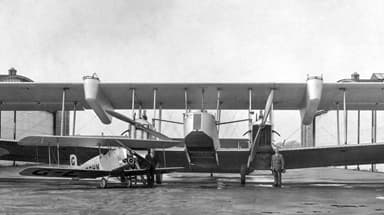
https://www.baesystems.com/en-uk/heritage/vickers-virginia
The specification of the later Virginia X was as follows:
- Length 52 ft, height 18 ft, wing span 87.5 ft, wing area 2,178 sq ft
- Empty weight 9,650 lb, gross weight 17,600 lb, crew four
- Two Napier Lion VB 12-cylinder water-cooled broad arrow engines, 580 hp each
- Max speed 108 mph, range 985 mi, ceiling 13,800 ft, climb 10 min to 5,000 ft
- Three 0.303 inch Vickers machine guns, 3,000 lb bomb load
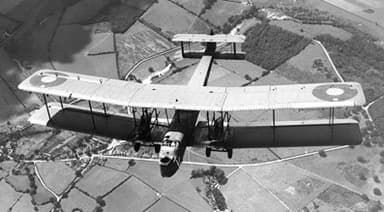
https://en.wikipedia.org/wiki/Vickers_Virginia#/media/File:Vickers_Virginia_in_flight.jpg
British Fairey Flycatcher Biplane Carrier-Borne Fighter
The Fairey Flycatcher was a single-seat, carrier-borne fighter biplane which served with the British Fleet Arm from 1923 to 1934. Pilots found it easy to fly and very maneuverable. In fact, it became the basis for combat tactics used in the Second World War.
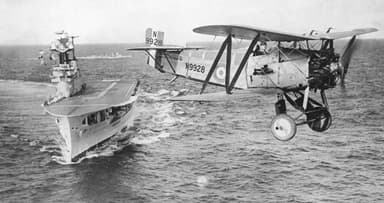
https://en.wikipedia.org/wiki/File:Fairey_Flycatcher.jpg
The Fairey Flycatcher came with conventional undercarriage for carrier use as standard. Although this could be exchanged for floats for catapult use, aboard large battleships that relied on cranes to recover seaplanes. Its design was quite remarkable for its era, being structured for operation from aircraft carriers for the first time.
Aileron flaps ran the entire trailing edges of both wings. These could be lowered for landing and take-off, enabling the aircraft ‘to come and go’ within three hundred feet. It also had hydraulic brakes to help it stop in the confined space of an aircraft carrier. Early models had arrestor hooks on the undercarriage spreader bar.

https://commons.wikimedia.org/w/index.php?search=Fairey+Flycatcher&title=Special%3ASearch&go=Go&ns0=1&ns6=1&ns12=1&ns14=1&ns100=1&ns106=1#/media/File:Fairey_Flycatcher_(replica)_AN0857734.jpg
The specification of the Flycatcher 1 was as follows:
- Length 23 ft, height 12 ft, wing span 29 ft, wing area 288 sq ft
- Empty weight 2,038 lb, gross weight 3,028 lb, crew one
- Jaguar IV 14-cylinder two-row air-cooled radial piston engine, 400 hp
- Max 133 mph, range 310 mi, ceiling 19,000 ft, climb 10,000 ft / 5.5 min
- Two fixed forward firing Vickers machine guns, four 20lb bombs
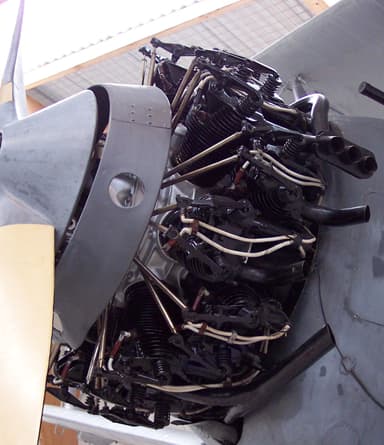
https://en.wikipedia.org/wiki/Armstrong_Siddeley_Jaguar#/media/File:Armstrong_Siddeley_Jaguar_IV_on_Hawker_Dankok.jpg
French Potez XVIII Twelve-Passenger Luxury Biplane Airliner
The Potez XVIII was a bold attempt to seize the moment when public interest in air travel was growing. However, their twelve-passenger biplane airliner was a far cry from squeezing into modified military aircraft. In fact, it was more reminiscent of passenger rail travel in the early 1920’s.
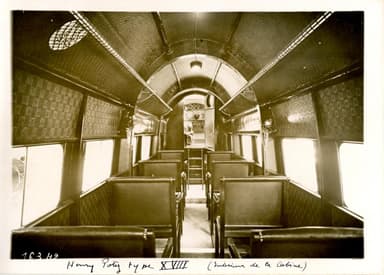
https://www.abebooks.com/photographs/Avion-Henry-Potez-type-XVIII-Photographie/30061446964/bd
The Potez XVIII took ideas from the Potez X colonial transport aircraft. Accordingly, it was an unequal span biplane built largely of wood, although with metal engine mountings and other fittings, engine nacelles and tail surfaces. But the wings themselves were still covered in fabric.
The pilot and engineer / navigator sat ahead of the wings in an open cockpit. However, this had a door leading down to the passenger cabin, with a central aisle with single seats on either side. A toilet and luggage compartment were at the tail end. The underwing, twin double wheels had shock absorbers, but there was a simple tail skid at the rear.

https://en.wikipedia.org/wiki/File:Potez_XVIII_L%27A%C3%A9ronautique_December,1922.jpg
The first test flight was on December 5, 1922, although the test program continued through to the spring of 1924. The French government purchased the prototype. But there the story ends. Perhaps the aircraft was just too radical for its day.
The specification of the Potez XVIII was as follows:
- Length 48.5 ft, height 13 ft, wing span 72 ft, wing area 1,210 sq ft
- Empty weight 6,393 lb, gross weight 10,527 lb, crew 2, passengers 12
- Three Lorraine 8Bd water-cooled V-8 piston engines, 270 hp each
- Max speed 121 mph, endurance four hours, service ceiling 16,000 ft
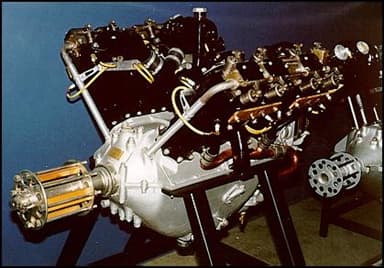
https://en.wikipedia.org/wiki/Lorraine-Dietrich_aero-engines#/media/File:Lorraine-Dietrich_8Be.jpg
DECEMBER 1922
A Dornier Komet from Deutsche Luft-Reederei becomes the first German aircraft to fly over the United Kingdom since the end of World War I.








